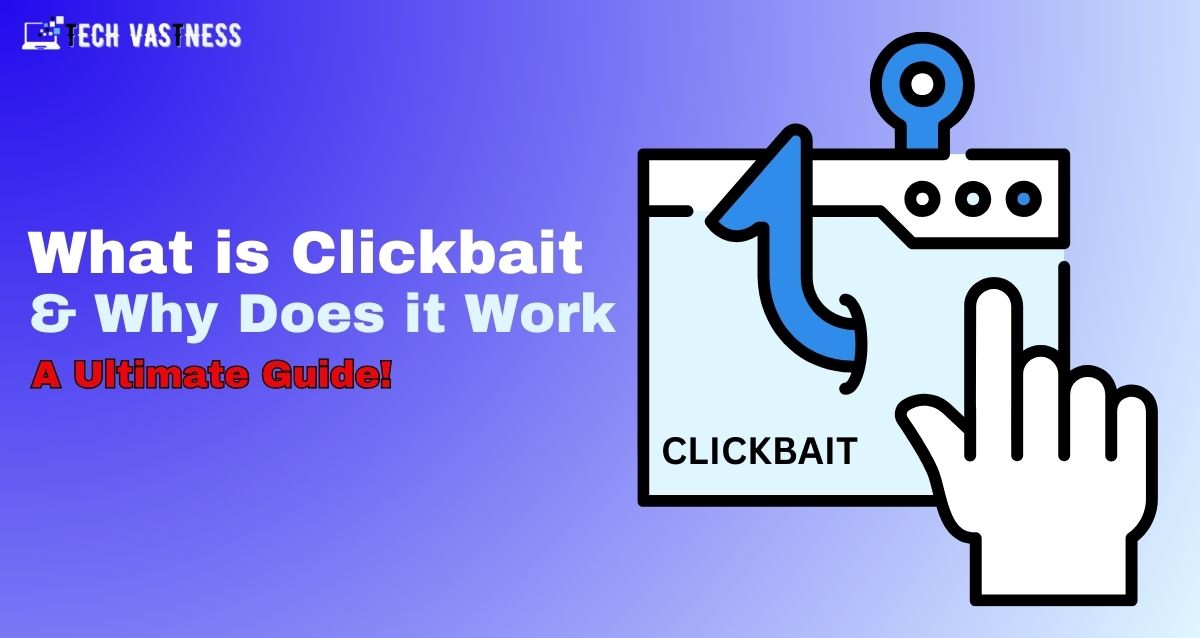What is clickbait? Clickbait sounds like an enticing content marketing strategy, as it’s meant to hook a reader into visiting your link. After all your hard work in creating content, you want website traffic and more users.
In recent years, clickbait has gotten a bad rap.
In the age of misinformation, people are reluctant to make sensational claims.
When done right, clickbait is one of the most effective ways to get viewers’ attention and drive more traffic toward your content.
However, what’s crucial is once you get them to your website, you offer more than just a catchy title.
In this blog post, we’ll explain what clickbait is, how to do it ethically, and why you should use it more.
What Is Clickbait?
Clickbait is online content built to entice visitors and earn page views. Its titles and thumbnail links encourage internet users to visit the link to read, listen, or watch the content. Clickbait content is also highly shareable, as it uses emotional language.
Clickbait is any content written to attract hits. This usually contains:
✅ A catchy or compelling headline
✅ A strong appeal to emotion
✅ Scannable content optimized for web reading
✅ Witty copy
✅ Content aimed at social media sharing
Although clickbait content is usually associated with misleading or sensationalized online content and even fake news, hence this content earned a bad reputation.
In the 21st century, catchy newspaper titles have become catchy blog titles.
With the introduction of SEO (search engine optimization), and more brands wanting to increase traffic to their website, publishing popular listicle content such as: “21 Famous Actors Who Tricked You Into Thinking They’re Indian”.
This content was widely successful, crucially due to social media’s fame and relatable content’s virality.
These days, it is used in every type of digital content, from “Different Types of Keywords in SEO With Example” to “All SEO Types (Search Engine Optimization).”Yeah, I use it too, when it makes sense.
Is clickbait good or bad?
Clickbait is not inherently bad by definition. Unfortunately, it is used for bad purposes.
“Good” clickbait consists of a tempting headline and a provocative thumbnail that leads users to the expected content.
“Bad” clickbait tempts readers to click, without delivering the promise of the headline and image. Worse, it leads to an irrelevant or malicious site.
You’ve Perhaps heard that all forms of clickbait are bad. Why is clickbait bad though?
Google might punish your website if it finds out that you mislead online readers with a title and URL that are irrelevant to your page. As a result, your ranking will be affected. In addition, if your website users notice that you always use superlatives and exaggerated claims, you will lose their trust and they won’t hit on your links anymore.
What is an example of a clickbait?
Clickbait content can be anything, from videos to blogs, ads, news articles, and beyond.
The most common types add listicles, how-tos, and blog posts that capitalize on trending topics.
Here are some examples of common headings:
- “A Complete Guide to _____”
- “The X Ways to Improve Your _____”
- “A List of the Great in _____ L.A.”
- “The Secret to ____ That Will Change Your Life.”
- “Why We Like ____ and Why You Will, Too.”
- “You’ll Never Guess What Did _____ Last Morning.”
You’ll also see clickbait headlines on video platforms such as YouTube. YouTube channel for good examples of attention-grabbing headlines below:
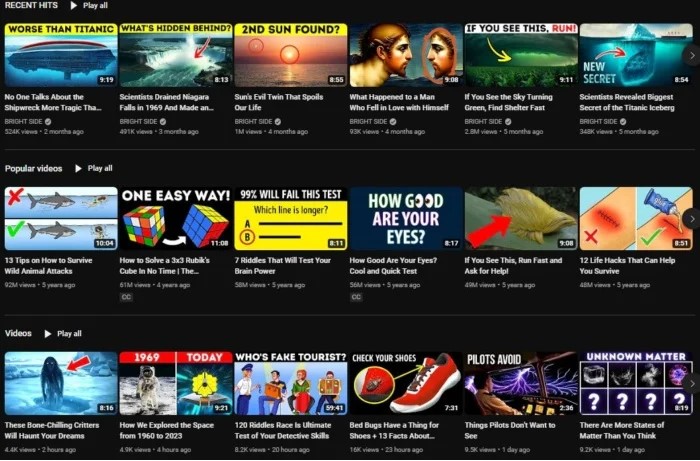
Why Clickbait Works
Clickbait often gets bad infamy online, mostly due to allegations about misleading content.
That being said, many ways exist to leverage it ethically without misleading your readers.
It works because of its ability to hit into genuine human emotion & curiosity.
Everyone wants to know the secret to increasing domain authority, just like everyone wants to know about becoming a freelance digital marketer & finding projects.
It’s called the curiosity gap psychological feeling of wanting to know more.
Marketers and writers structure clickbait headlines to make the audience think they will learn something new by clicking the link.
The necessary ethical note is to offer real value within your content rather than using a misleading title to get page traffic.
Clickbait is also a crucial part of measuring online success.
If no one hits your blog post, you lose the opportunity to talk to thousands of potential clients.
If you want to expand your reach, then you want more hits. If want you more clicks, you need to create a strategy to get them.
That being said, you don’t have to resort to sensationalism to do this.
Instead, think about the goal of your users. My blog, for example, teaches users about digital marketing techniques. While it may use catchy titles, like “What 15 Types of Backlinks in SEO are Needed Right Now,” or “How to Make Money Online for Beginners? Top 20 Ways,” it offers actionable information within those blogs that help viewers achieve their goals.
When using clickbait strategies, focus on your customer’s pain points and build content that educates and excites them.
If your title matches your content, you can avoid user backlash.
How to Avoid clickbait
While clickbait can be a victorious digital marketing strategy, it can also lose your brand if done wrong.
Many social media websites and search engines have included rules in their policies to discourage the use of sensationalist or misleading content.
Google’s policy is “Ads that use clickbait tactics or sensationalist word or imagery to drive traffic.” This can add ads that:
- Claims to reveal secrets or other sensational information.
- Use wording like, “Click here to learn more …” or, “You won’t believe
- what happened next ….”
- Use altered images or disaster image.
- Add “before & after” photos showcasing crucial changes in the human body.
- Use negative events, like death, illness, or disaster, to evoke action in the audience.
On Facebook, clickbait posts will appear lower in News Feeds, and repeated sharing can result in page restrictions.
It’s also crucial to avoid misleading clickbait on your site because it can damage trust in your brand.
Finally, success comes down to two things:
#️⃣ 1. Write compelling, honest, engaging titles.
#️⃣ 2. Don’t disappoint your audience once they click on them.
Consequences of “Bad” Clickbait
Why would you want to use “bad” clickbait in your title? Here’s an instance of what I’m talking about:
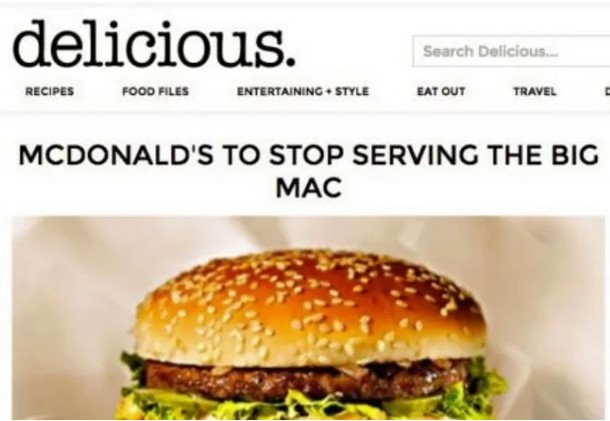
In this case, Delicious talked about the chicken Big Mac. The tale itself isn’t accurate. It’s just the title gives a different impression.
It’s tempting to get an audience eager to visit your website by adding a click-worthy title. However, that’s not going to create long-term success as:
- Bad clickbait (misleading titles, etc.) harms your trust and damages your credibility. You can’t expect the audience to trust you if it becomes obvious you’ve built a headline just to win clicks.
- Negative company image: If you build titles purely for clickbait, users could see your brand as manipulative and misleading. If your title promises something and your content doesn’t deliver, that doesn’t look great for your business.
- Lower engagement: Clickbait titles might get you a clickthrough. However, users of your page will likely exit when they realize the content doesn’t live up to the headline.
- Poor quality content: Do you want to engage viewers and keep them on your page? Then focus on quality content rather than clickbait-style titles or clickbait content. Write actionable material that your users can learn from. That’s how you get the audience to come back for more.
- Lower revenue: Got a service/product to sell? Want people to hang around long enough to consider buying? Or click on an affiliate link to earn a set commission? Your users are far less likely to do that if you rely on clickbait titles. Research also displays that websites depending on clickbait titles and clickbait content get a lower-than-expected ROI. This is because of the poor user experience and lower impact impressions.
7 Steps to Use Clickbait in Your Content Marketing Strategy
Now should you know how to use clickbait ethically, it’s time to implement this strategy in your content marketing.
Here’s how to get started below:
1️⃣ Use the curiosity gap, don’t exploit it. You avoid sensationalist material and inaccurate claims.
2️⃣ Be honest with your users and avoid misinformation. Set an example of honesty. According to Adobe, 7 in 10 clients purchase more from trustworthy brands. They’re also more likely to abandon brands they don’t trustworthiness. If you remain truthful with your audience you’ll have a good chance of converting them.
3️⃣ Use the number in your headline. Numbers represent actionable tips readers can use to reach their goals. Numbered lists also improve scannability and make it easy for users to digest content.
4️⃣ You pay attention to your data. When using clickbait titles, measure them against other headlines and see which performs well. Like anything in marketing, the numbers don’t lie. There’s no point investing in a tactic if it doesn’t work for your viewers.
5️⃣ The write for more than clicks. A headline is just the starting. What matters is the quality of your content as a whole. While a witty title may bring them to your page, your content makes them stay.
6️⃣ Add emotional triggers in your titles, because they tend to resonate with users and encourage them to click through and read more. Power words such as “secret,” “free,” “easy,” or “now,” create a psychological response in the audience and encourage action.
7️⃣ Don’t be afraid to make bold claims in your headline. Although, make sure you deliver on the promises you build in your content.
😊 Remember, the primary goal of content marketing is to make engaging content that provides value to your user. To capture attention, you can use clickbait tactics. However, you must balance it with valuable content for your readers, and your headlines accurately reflect your content.
How To Write Clickbait Titles
Now that you know, what is clickbait. Ready to begin writing a clickbait title of your own? Follow the tips to write the best headline that drives clicks.

1️⃣ Use Google Alerts to Seek Out What’s Trending
Leveraging popular trends and news is the best way to engage your users.
By setting up Google Alerts for viral or trending topics, you can stay ahead of your competitors and be the first to break the news to your viewers.
Pair your viral titles with relevant keywords to boost your SEO.
2️⃣ Use Numbers or Listicle Format
Numbers are an old blogging trend that increases reader engagement.
Using numbers in blog titles is effective because it shows your readers that there are actionable steps to follow, and the content is easy to scan.
As online users find quick, efficient information, they prefer content they can easily access and ingest.
Numbers also imply the presence of a listicle, which is often the most shared blog post type on the internet.
3️⃣ Offer Immediate Value to Your Users
Offering immediate value is the best way to encourage clicks on your post.
You can offer physical value via discounts, consultation services, free products, and more. Or, you can offer something less tangible, like a secret or an industry trick.
When using these clickbait marketing strategies, ensure to follow through with your promise in your post.
No one wants a misleading title; you’ll lose your reader’s attention if you don’t seem trustworthy.
4️⃣ Use a Teaser
One of the great clickbait strategies is to use a teaser in your title.
You’re leveraging the curiosity gap and building immediate engagement by suggesting the user will seek something they don’t already know in your post.
A teaser can be several things, like “The X things you wish you know…” or “You’ll never guess what __ did in London.”
😊 As we talk before, make sure to follow through with your tease in the body of your post to avoid annoying your viewers.
8 Ways For Creating A Clickbait Headline
You better understand what clickbait is now. However, you know it’s not all bad. You also know it can elevate click-throughs now. Now it’s time to put it all together in the following ways.
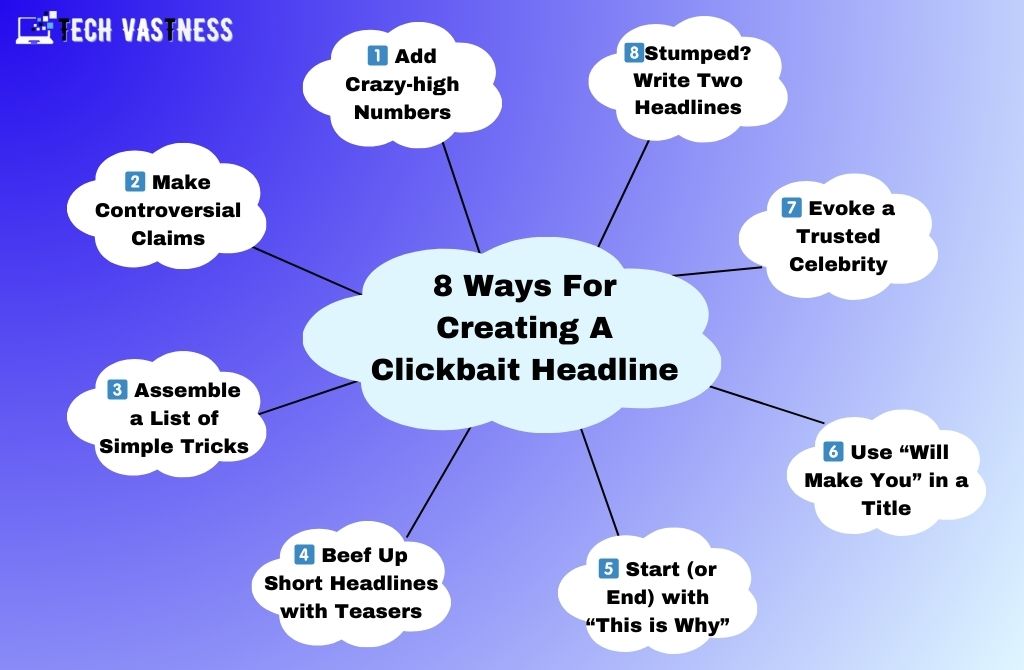
1️⃣ Add Crazy-high Numbers
Everyone’s impressed when you can walk out a money large.
This could relate to money, percentages, or anything else.
For example, I got more engagement in my post about YouTube advertising spend.
2️⃣ Make Controversial Claims
However, it’s the best for creating viral content, controversy isn’t always well for business.
Although, sometimes it can get you more attention.
You don’t want to begin controversy just to be controversial. That’s big silly.
Although, if you have an opinion contrary to the status quo, go ahead and share it.
3️⃣ Assemble a List of Simple Tricks
Mark your attendance, who doesn’t like listicles? They are probably one of the most famous forms of content as they’re easy to scan and absorb.
Listicles work better — not just for clickbait but also for SEO.
One method to jazz them up is to use adjectives to describe the tips, tricks, or things you’re going to list.
- 7 simple tricks to…
- 10 Tips…
- 10 crazy ways to…
- 7 Simple strategies…
- 31 magical fixes for…
- 17 Best Methods…
You get the core point. Include an appealing adjective to the listicle headline to make it even more clickbait-y.
4️⃣ Beef Up Short Headlines with Teasers
We’ve all viewed the clickbait titles that call out a few revelations in the post; you can do the same.
For example, if you’re writing a short, SEO-optimized title, you can transform it into clickbait. Here are some examples off the top of my head:
- 25 Ways to Boost Traffic by 206% (You Can’t-Miss #22)
- 20 Tricks for Better Lead Gen (Try #18 First)
- 9 Simple Strategies for Better Social Engagement (#9 Can’t Lose)
You get the core point. It’s like a film trailer — tease what the viewer has to gain by clicking.
5️⃣ Start (or End) with “This is Why”
Including “this is why” somewhere in your SEO-optimized titles can transform it into effective clickbait.
You have 2 options for this strategy.
The first is to begin with the sentence “This is Why.”
However, modern SEO best practices add moving the most crucial words in the headline to the beginning. All we need is a few fancy rearranging.
Here, we’ve changed “This Is Why You Can’t Grow Your Website Traffic” to “You Can’t Grow Your Website Traffic (This Is Why).
That’s a simple but compelling way to get the audience to click.
6️⃣ Use “Will Make You” in a Title
It’s the best construction for an SEO-optimized headline as it lets you put your most crucial keyword at the start of the title. For instance:
- These X SEO Tricks Will Make You 300% Make Money
- Check Out X Digital Marketing Hacks That Will Make You Marketing Famous
- Our New SEO Service Will Make You Sigh With Relief
7️⃣ Evoke a Trusted Celebrity
No, you shouldn’t turn your site into a tabloid rag. Put that thought instant out of your mind.
However, you could use a well-known name in your niche to combine clickbait and SEO in your title.
We can’t all sit down for a chat with a celebrity.
However, you could use quotes from your subject’s latest book or recent posts, For example.
I’ve read lots of posts in this vein. You can write them, too, if you’re creative.
8️⃣ Stumped? Write Two Headlines
When you can’t transform an SEO-optimized headline into clickbait, you have another option.
What you might not realize is that you can put 2 titles in a single post or page:
#️⃣ 1. Title tag: This headline goes within the tags on a web page. It appears in search engines and the browser bar when somebody clicks on it.
#️⃣ 2. H1: The H1 tag goes within tags and appears at the top of your post if you decide to put it there.
If you use WordPress, you can easily differentiate your headline and H1 tag using Yoast. It’s a plugin that gives you control over your SEO.
For instance, use the SEO title in the headline field on your WordPress article page. Then, include the clickbait title in the field in the Yoast section.
In this method, search engines will see the SEO-optimized headline embedded in the H1 tags, but the audience will see the clickbait title when they peruse the search engines.
It’s a win-win situation, right?
Clickbait Titles Examples
Can you guess one of the secrets to success on YouTube Shorts? Yeah, it’s clickbait. Again, that doesn’t mean misleading titles. It refers to titles designed to get a clickthrough, like this one from Harsha Sai – For You Hindi.
The Indian media personality, who carries out acts of kindness, uploaded an inspiring video to YouTube Shorts.
It’s titled “For her grandson’s education” and shows how Harsha Sai befriended a poor boy and got him an education.
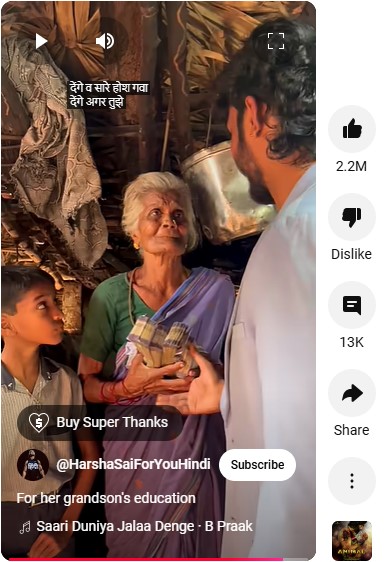
The title is guaranteed to get hits as well as warm the heart.
However, If you want more lessons in clickbait marketing, look no further than Buzzfeed.
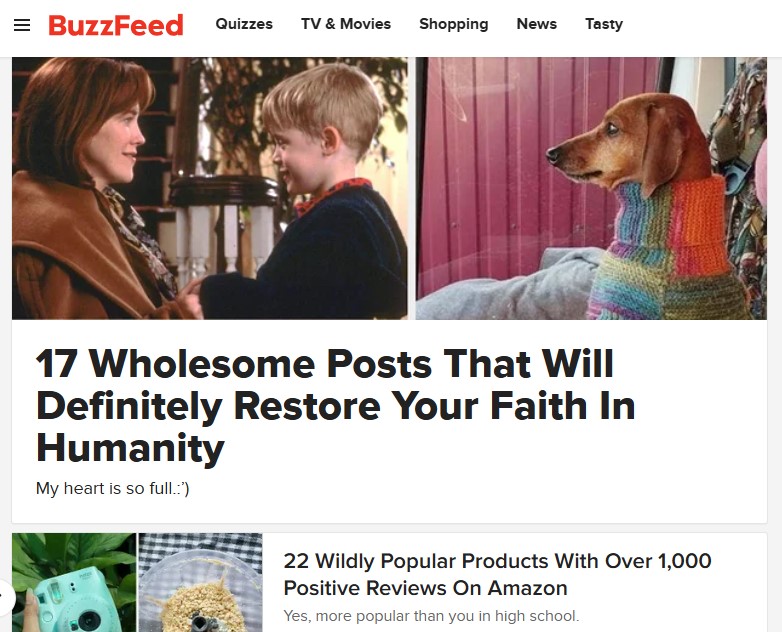
Years ago, the website mastered clickbait-style titles. Just hit the homepage for some inspiration. Want to see what Buzzfeed does?
It builds intrigue, engagement, and excitement. The titles make you want to click through.
Most crucially, though, its posts rarely disappoint.
What makes good clickbait?
Everyone wants their content to be read and clicked, and their webpages to rank on search engines. However bad clickbait practices are counterproductive as they’ll damage your reputation among users and hurt your rankings.
Instead, practice the following to ensure your posts are being consumed by your target audience:
Find out what your people are searching for through keyword research.
Keyword research helps you seek target keywords that you can add to your page’s headline, headings, and on-page content. Sprinkle your target keywords throughout your content, so search engines such as Google will seek your page to be relevant to these keywords. Tools like keywords Google Keyword Planner, Semrush, Ahrefs, and Ubersuggesst can help you with your keyword research efforts.
Keyword research will help you with your content marketing strategy and help you answer questions like:
- What posts or videos should I publish?
- Which existing pages should I optimize for certain famous keywords?
Identify the searcher’s intent
Search intent is the reason behind a searcher’s search inquiry. A person is most likely looking for answers, hence create content — optimize an existing one — that addresses a user’s problem. There are 4 common types of intent:
1️⃣ Informational: The most common intent, is a type of search intent that wants to learn about a certain subject or topic. These searches take place when readers are in the discovery phase. For instance, people who search ” what’s a good road car” are looking for more information about road cars and are not yet ready to purchase one.
2️⃣ Navigational: This type of search happens when a person has a brand in mind but may need the help of a search engine to get to a product page. For instance, a person types in “Mahindra road cars” to look for Mahindra’s webpage that lists all its road cars.
3️⃣ Transactional: The buying intent for these searches is high. Phrases such as “sale,” “price,” “or “pricing” are in the queries as they’re almost ready to buy.
4️⃣ Commercial: A mix of informational and transactional intent, commercial searches have people ready to buy, but want more information to guide them to the purchase. In our earlier example of road cars, a user can do further research by searching, “Mahindra BE 6E.”
😊 Are Internet readers looking for your products’ price list? Optimize your existing price page, so can easily seek it. Are readers looking for your products’ specs? Ensure you optimize your product pages, and they appear in searches when people look for “product x features.”
Conclusion
We have learned what clickbait is. Although it often gets bad press, clickbait is a crucial marketing strategy that can help improve traffic to your content or site.
When using this strategy, it’s vital to be ethical and not mislead your readers or capitalize on negative content to boost your views.
However, if you believe in your posts and think they will benefit your audience, there’s no reason to feel bad about making enticing headlines.
Read More Blogs:

